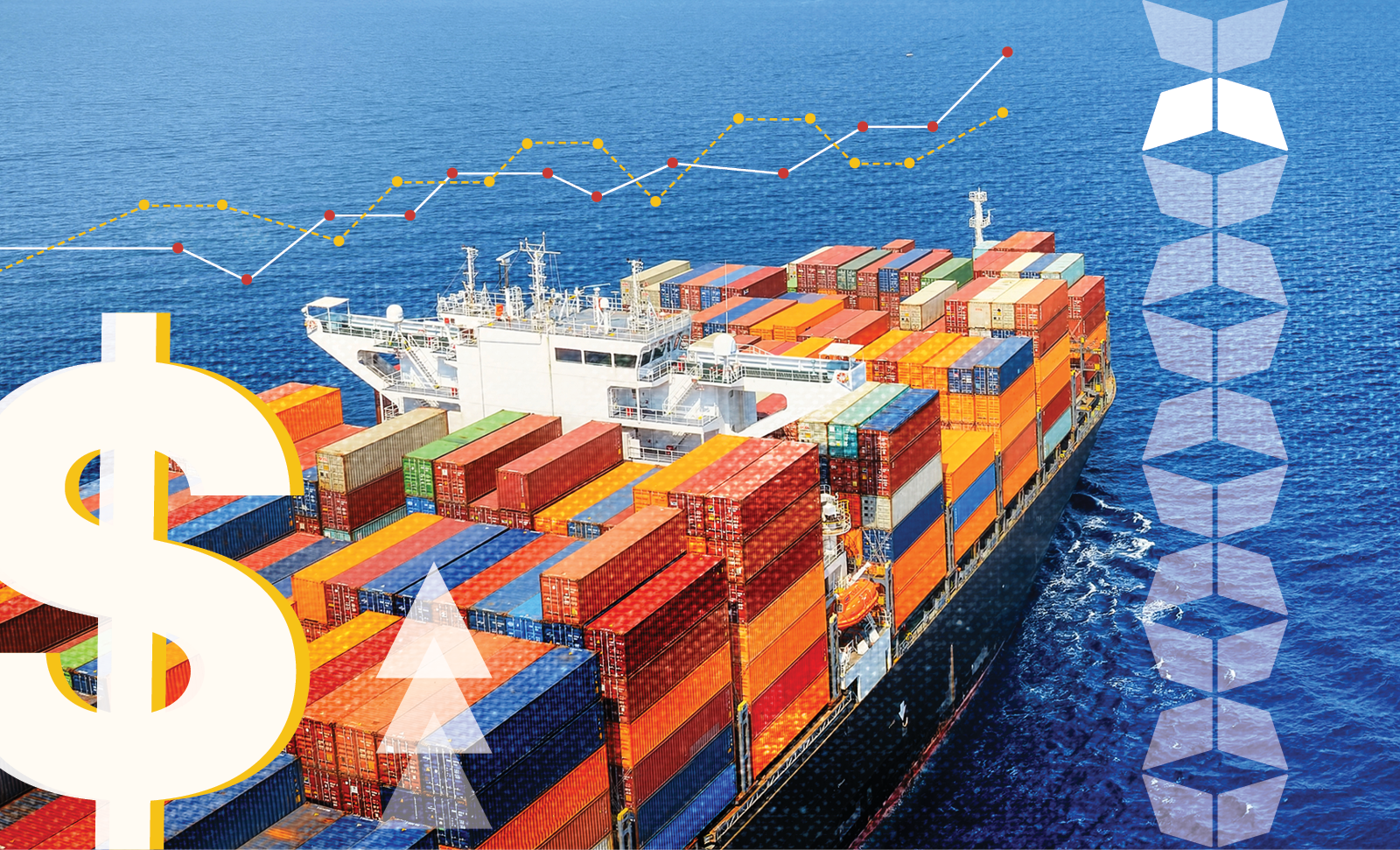5 Factors That Affect Freight Rates
Originally posted May 21, 2021, updated August 25, 2025.
The cost of transporting materials and goods from one location and another can have a significant impact on a business’s bottom line. That said, transport is a central theme in the supply chain.
Freight rates play a big role: they affect operational costs and profitability, pricing strategies, supply chain efficiency and planning, and they are often an indicator of the economy’s overall health. With the current fluctuations and ongoing impacts of shifting policies and tariffs, transportation and freight rates have become a focal point.
From April through June 2025, the freight market showed mixed signals but continued weakness overall. In April, freight expenditures rose year-over-year for the first time in 28 months, though this was driven by higher rates rather than shipping volumes, which actually fell 3.6%. May typically sees a seasonal uptick in domestic freight, but volumes instead slipped by nearly half a percent, with shifts from LTL to truckload and destocking of pre-tariff inventory playing a role. By June, the downturn had deepened, marking the 29ᵗʰ consecutive month of declining freight volumes, well beyond a typical down-cycle, leaving the transportation sector’s rebound uncertain in the face of tariffs and unclear consumer impacts.
Budgeting for freight transportation services is essential for any supply chain and logistics company; and can be critical in uncertain times. This article will explore what defines freight rate, five factors that have a major impact on freight rates, and how that impacts businesses.
Defining freight rates
Freight rates are the cost of moving cargo from one point to another. They are determined by numerous factors, including the type of goods or materials, modes of transport (truck, ship, rail, or air), weight, volume, dimensions, and delivery distance. Many carriers also use dimensional weight to account for both size and mass when pricing shipments.
While rates fluctuate constantly in response to market conditions, the one constant is their direct influence on profitability. Careful planning and budgeting for freight costs are therefore essential for logistics and supply chain organizations, particularly as rate variability can make forecasting and cost control a complex, resource-intensive task.
5 Factors that affect freight rates
Businesses looking to control freight costs either need to stay on top of fluctuations and adjust strategically or have an outstanding and agile strategic partner that can do it for them.
The factors affecting freight rates span everything from operational choices to outside disruptions and require the ability to optimize routes, negotiate with carriers, and leverage technology across transportation modes. Here are five factors to consider:
1. Meeting expectations
Businesses across the spectrum, from manufacturers to retail brands, expect freight partners that can help them navigate the full cycle with agility, balancing cost control with performance. Retailers wrestle with expensive last-mile delivery and heightened consumer demands for speed, while manufacturers require technology that delivers visibility into moving high volumes of heavy or specialized goods across long distances. Both are also under pressure to advance sustainability initiatives without shouldering prohibitive costs tied to eco-friendly fleets and compliance. This is where freight brokers prove essential: by leveraging diverse networks, multiple modes, and strategic carrier relationships, brokers help brands flex capacity around seasonality, diversify risk, and optimize for cost, service, and sustainability, keeping expectations met on every front.
2. Weight and dimensions
Weight and dimension are two of the most influential factors in freight costs as they directly affect how much space and capacity a shipment consumes. Carriers calculate charges not just by actual weight but dimensional weight, a pricing method that looks at both size and mass.
Think of it like this: There are bulky, lightweight shipments that take up significant room but don’t weigh much. For example, a large box of pillows may cost more to ship than a smaller, heavier box of tools because it reduces how much else can fit on a truck or plane. However, the freight cost for pillows may be reduced if they can be vacuum-packed, which depends on if it would damage them.
The bottom line is, the heavier or more oversized a shipment is, the more fuel, handling, and space it requires, which drives costs higher across modes of transport. Efficient packaging and accurate measurements are therefore critical to keeping freight expenses under control.
3. Distance, mode, and infrastructure
In general, shipping costs rise with distance. However, mileage is only one piece of the equation. Freight rates are also determined by geographic location and challenges, mode of transportation, regional infrastructure, and available capacity. This is why an experienced 3PL partner or transportation manager provides value: they can design strategies that balance cost efficiency with service reliability. A strategy may include building multi-node fulfillment networks near major customer hubs, consolidating shipments to maximize truck capacity, and reducing costly out-of-route deliveries, which helps businesses control expenses while maintaining speed. Thoughtful network design and mode diversification turns distance into a manageable, rather than limiting, factor in the overall transportation budget.

4. Regulations and compliance
Regulations heavily influence freight rates as carriers and shippers much meet standards that vary across regions and modes of transportation. Businesses must comply with safety protocols, hazardous materials handling, environmental mandates, and customer requirements, all of which can increase operational complexity and cost. For example, adhering to emissions regulations may require investment in newer, eco-friendly fleets or cleaner fuels, while cross-border shipping introduces tariffs, duties, and documentation that add administrative and financial burdens. These costs inevitably impact freight rates, making regulatory compliance a critical factor for any company managing domestic or international supply chains.
5. Disruptions
The supply chain has seen numerous disruptions that continue to cause fluctuations in freight rates, at times causing them to spike quickly. Extreme weather, port congestion, labor strikes, geopolitical conflict, or sudden demand surges all affect freight rates. These disruptions tighten capacity, slow down networks, and force carriers to reroute or prioritize shipments, driving up costs.
Even short-term interruptions affect global supply chains, creating imbalances in equipment availability, bottlenecks in major hubs, and surcharges for expedited service. Because disruptions are unpredictable yet inevitable, freight rates often reflect built-in premiums for risk, and brands that lack diversified networks or flexible transportation strategies may feel the cost impacts most acutely.
How the right freight broker drives cost-efficiency and mitigates risks
The right freight broker is a strategic partner that helps balance cost, service, and resilience. By tapping into broad carrier networks, leveraging technology, and anticipating disruptions, freight brokers give businesses the agility they need to navigate shifting rates, seasonal surges, and regulatory demands while keeping transportation spend under control.
The right broker will add value through:
- Network leverage: Access to a diverse pool of carriers and modes to secure competitive rates and capacity.
- Mode optimization: Matching shipments to the most cost-effective mode (LTL, truckload, intermodal, or expedited) without compromising service.
- Disruption management: Mitigating risks from weather, strikes, or port congestion through rerouting and contingency planning.
- Visibility and analytics: Providing real-time data and predictive insights to improve decision-making and reduce inefficiencies.
- Scalability: Supporting seasonal spikes and long-term growth without the overhead of managing carrier relationships directly.
- Compliance expertise: Ensuring adherence to safety, environmental, and customs regulations while minimizing delays and fines.
The WSI difference
Every business that manufactures or sells physical goods relies on transportation, and the stakes have never been higher. To keep pace with customer expectations, control costs, and navigate disruption, you need a the right partner.
With WSI, you gain access to an international logistics network, the largest rail-served warehouse footprint in the U.S., flexible small-parcel and multimodal solutions, and customizable 3PL services designed to scale with your business. Whether you’re moving products across town or across the globe, WSI has the expertise, network, and technology to get you there. Connect with WSI today to turn transportation into a competitive advantage.
About the Author

Alyssa Wolfe
Alyssa Wolfe is a content strategist, storyteller, and creative and content lead with over a decade of experience shaping brand narratives across industries including retail, travel, logistics, fintech, SaaS, B2C, and B2B services. She specializes in turning complex ideas into clear, human-centered content that connects, informs, and inspires. With a background in journalism, marketing, and digital strategy, Alyssa brings a sharp editorial eye and a collaborative spirit to every project. Her work spans thought leadership, executive ghostwriting, brand messaging, and educational content—all grounded in a deep understanding of audience needs and business goals. Alyssa is passionate about the power of language to drive clarity and change, and she believes the best content not only tells a story, but builds trust and sparks action.



